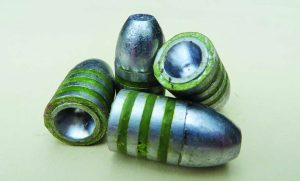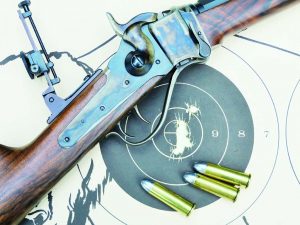by Mike Nesbitt | Contributing Editor
The Bull Shop has been providing cast bullets for over 25 years now and their bullet lubes, especially the blackpowder NASA lube, have received several recommendations. I had contact with The Bull Shop years ago when they were in Alaska and now, after they have moved to Montana, we make contact again.

My “camp” Sharps in .50/70 with the 26” half-round barrel.
What brought me to The Bull Shop was my search for a better bullet for my Sharps .50/70 rifles. The Bull Shop offers a real wide list of cast bullets from .22s on up that includes a couple of different bullet styles for the .50/70s. One of those styles is a hollow based 450 grainer cast from an NOE mold. I was considering the purchase of that NOE mold and shooting some bullets cast by The Bull Shop was a quick way for me to help make up my mind. The Bull Shop offers these bullets sized to either .512” or .515” diameters and lubed with either a smokeless lube or their NASA lube for blackpowder shooting. My selection was the .512” diameter bullets lubed with NASA.
Before I get more specific about those bullets, let me say that The Bull Shop has at least 20 different .50 caliber cast bullets to offer, with weights from 300 to 750 grains. Those are just the .50 caliber bullets and their complete list of available bullet styles is over 250 in a wide range of diameters from .22s on up to a .54 caliber. Within that wide range of bullet diameters and styles, there are several options which include a sized diameter, choice of lubricant, and on certain bullets, gas checks.
The .50 caliber bullets I tried were cast from what The Bull Shop refers to as their “standard” lead. That is scrap lead which is mixed to approximate the hardness of a 20-1 alloy. They do offer a 20-1 alloy of lead and tin at a 35% increase in price. Also for 30-1 and for pure lead.

Here are four of the bullets for the .50/70 from The Bull Shop.
Now for some specs. When I first tried the 450-grain NOE .50/70 bullets from The Bull Shop it was in my “heavy” .50/70 with the 32” barrel. Those bullets were loaded into Star Line .50/70 cases over 65 grains of Olde Eynsford 2F which was compressed under a .060” Walters’ fiber wad. Then the bullets were seated by hand in the fire-formed cases and given a taper crimp for security.
Shooting those loads was simply a disappointment. They all printed on the targets at 50 and 100 yards but not with good grouping. Somehow those bullets were not matched to the rifle.
Next I used my “camp” .50/70 with the 26” half-round barrel. The loads used this time had the same brass but no wad was placed between the bullet and the powder. Instead the bullets were simply seated down on the powder using the standard seating die, compressing the 65-grain powder charge just a little bit. The soft bullets were not deformed during the seating process and the hollow base must help to make seating of the bullets rather easy.
One characteristic about these bullets, in my humble opinion, is that they don’t have large enough lube grooves. I say that based on two things, (1) other bullets I’ve used in the .50/70s have larger grease grooves and (2) the “lube star” at my 26” barreled gun’s muzzle was very thin and dry looking. Yes, these bullets are lubed with NASA lube and I have no question about that. I only wish the bullet carried more lube.

This 5-shot group was fired using the Bull Shop cast bullets.
Now, in the 26” barreled rifle these bullets simply performed with excellence. This shooting was done at just 50 yards but it was very pleasing. My first 5-shot group, fired while using a blow-tube between shots, would have scored a 50-3X in our short-range competition. (That shot at 1:00 o’clock looks like a 9 but it “pushed” the line to the 10 ring out of its way.) Then I fired a second group and that one is not quite as good, it scored a 47 with a close cluster of two 10s and three 9s. Those two groups were fired without cleaning the barrel after the first target. That second group is just one thing that makes me think this bullet could carry more lube. Cleaning the gun between targets, of course, is a much quicker fix than redesigning the bullet.
Not enough lube might be the reason why these bullet worked through the 26” barreled rifle but not through the 32” barrel. They seem to have simply run out of lube while traveling through the longer barrel.
Also, the NOE 450-grain bullets for the .50/70 are hollow based, that’s been mentioned. However, The Bull Shop believes NOE’s hollow base is too wide, leaving too thin of a skirt. So The Bull Shop uses a smaller hollow base pin, which produces a smaller hollow in the base of the bullets. They have promised me to make their hollow base pin fit a bit better to make the base of the bullet smooth. And, let me say that I think The Bull Shop is right, the hollow base as the mold comes from NOE seems to be larger than necessary.
My feelings now are that the 450-grain hollow based bullets from The Bull Shop are very good and they will be put to their best use in rifles with 28” barrels or shorter when fired with blackpowder loads. That might mean these bullets would be perfect in .50/70 carbines or just short barreled rifles like mine. I’ll be getting more of these bullets; I do know that. Maybe someday I’ll do some hunting with them.
The Bull Shop’s price for these bullets is rather outstanding. They price their bullets by weight and for the 450-grain bullets just talked about the price per 100 is $27.50. That price is good for bullets weighing 450 to 499 grains. And, just for comparison, bullets weighing 400 to 449 grains are priced at $26.00 per 100. Using The Bull Shop’s reasonably priced cast bullets will allow several shooters, like me, the chance to try certain cast bullets before buying the bullet molds. Or, considering my own situation again, I just might continue buying bullets from The Bull Shop instead of buying the mold.
To see the extensive line-up of cast bullets available from The Bull Shop, visit their website at: bullshop.weebly.com. To make more direct contact, by mail write to The Bull Shop, PO Box 240030, Dell, MT 59724. They can also be emailed at: bullshop@3rivers.net or called at 406-276-3394.



